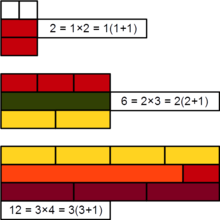Pronic number

A pronic number is a number which is the product of two consecutive integers, that is, a number of the form n(n + 1).[1] The study of these numbers dates back to Aristotle. They are also called oblong numbers, heteromecic numbers,[2] or rectangular numbers;[3] however, the "rectangular number" name has also been applied to the composite numbers.[4][5]
The first few pronic numbers are:
- 0, 2, 6, 12, 20, 30, 42, 56, 72, 90, 110, 132, 156, 182, 210, 240, 272, 306, 342, 380, 420, 462 … (sequence A002378 in the OEIS).
As figurate numbers

The pronic numbers were studied as figurate numbers alongside the triangular numbers and square numbers in Aristotle's Metaphysics,[2] and their discovery has been attributed much earlier to the Pythagoreans.[3] As a kind of figurate number, the pronic numbers are sometimes called oblong[2] because they are analogous to polygonal numbers in this way:[1]








































1×2 2×3 3×4 4×5
The nth pronic number is twice the nth triangular number[1][2] and n more than the nth square number, as given by the alternative formula n2 + n for pronic numbers. The nth pronic number is also the difference between the odd square (2n + 1)2 and the (n+1)st centered hexagonal number.
Sum of reciprocals
The sum of the reciprocals of the pronic numbers (excluding 0) is a telescoping series that sums to 1:[6]
The partial sum of the first n terms in this series is[6]
Additional properties

The nth pronic number is the sum of the first n even integers.[2] It follows that all pronic numbers are even, and that 2 is the only prime pronic number. It is also the only pronic number in the Fibonacci sequence and the only pronic Lucas number.[7][8]
The number of off-diagonal entries in a square matrix is always a pronic number.[9]
The fact that consecutive integers are coprime and that a pronic number is the product of two consecutive integers leads to a number of properties. Each distinct prime factor of a pronic number is present in only one of the factors n or n+1. Thus a pronic number is squarefree if and only if n and n + 1 are also squarefree. The number of distinct prime factors of a pronic number is the sum of the number of distinct prime factors of n and n + 1.
If 25 is appended to the decimal representation of any pronic number, the result is a square number e.g. 625 = 252, 1225 = 352. This is because
- .
References
- 1 2 3 Conway, J. H.; Guy, R. K. (1996), The Book of Numbers, New York: Copernicus, Figure 2.15, p. 34.
- 1 2 3 4 5 Knorr, Wilbur Richard (1975), The evolution of the Euclidean elements, Dordrecht-Boston, Mass.: D. Reidel Publishing Co., pp. 144–150, ISBN 90-277-0509-7, MR 0472300.
- 1 2 Ben-Menahem, Ari (2009), Historical Encyclopedia of Natural and Mathematical Sciences, Volume 1, Springer reference, Springer-Verlag, p. 161, ISBN 9783540688310.
- ↑ http://www.perseus.tufts.edu/hopper/text?doc=Perseus%3Atext%3A2008.01.0238%3Asection%3D42
- ↑ Higgins, Peter Michael (2008), Number Story: From Counting to Cryptography, Copernicus Books, p. 9, ISBN 9781848000018.
- 1 2 Frantz, Marc (2010), "The telescoping series in perspective", in Diefenderfer, Caren L.; Nelsen, Roger B., The Calculus Collection: A Resource for AP and Beyond, Classroom Resource Materials, Mathematical Association of America, pp. 467–468, ISBN 9780883857618.
- ↑ McDaniel, Wayne L. (1998), "Pronic Lucas numbers" (PDF), Fibonacci Quarterly, 36 (1): 60–62, MR 1605345.
- ↑ McDaniel, Wayne L. (1998), "Pronic Fibonacci numbers" (PDF), Fibonacci Quarterly, 36 (1): 56–59, MR 1605341.
- ↑ Rummel, Rudolf J. (1988), Applied Factor Analysis, Northwestern University Press, p. 319, ISBN 9780810108240.
